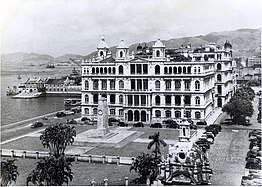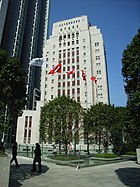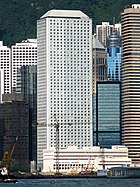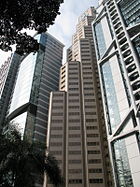P&T Group
| P&T Group 巴馬丹拿集團 巴马丹拿集团 | |
|---|---|
 | |
| Practice information | |
| Founded | 1868 |
| No. of employees | 1600+ |
| Location | Hong Kong Singapore Shanghai Dubai Abu Dhabi Wuhan Bangkok Ho Chi Minh City Shenzhen Macau Kuala Lumpur Jakarta |
| Significant works and honors | |
| Buildings | Exchange Square Jardine House Standard Chartered Bank Building |
| Projects | Over 5,000 finished |
| Website | |
| https://www.p-t-group.com/ | |
P&T Group (Chinese: 巴馬丹拿), formerly known as Palmer and Turner Hong Kong (Chinese: 公和洋行; "Kung Wo Yeung Hong"), is an architectural firm in Hong Kong. It is one of the oldest architecture and engineering firms in the world, and it has designed many landmark buildings in Hong Kong, Shanghai and in southeast Asia.[1]
History
[edit]Based in Hong Kong, P&T claims its roots when architect William Salway set up his own practice on 1 October 1868.[2] Herbert William Bird, a partner of the firm from 1901 to 1928,[3] was also a member of the Legislative Council of Hong Kong. Hong Kong public records suggest that Palmer & Turner arose out of Palmer & Bird – a prominent firm at the time whose senior partner was Lennox Godfrey Bird, younger brother of HW Bird.[4] It is known that Clement Palmer, then only 23 years of age, designed the first Hong Kong and Shanghai Bank Building in 1883. Arthur Turner, a structural engineer, joined the firm in 1884. From 1891 onwards, the name Palmer and Turner was kept, despite the arrival of new partners.[1]
During the late 19th and early 20th centuries, the practice was very active in colonial Hong Kong, and in Shanghai, which was a treaty port at the time. A Shanghai office of Palmer and Turner was opened in the mid-1920s, and it designed many important buildings that constitute the Old Bund in Shanghai, including the Peace Hotel.[1] Following a rule change by the architects' professional body, HKIA, in 1981, after which full liability partnerships could incorporate, the practice was incorporated and renamed P&T Group in 1982. Its holding company, which owns all its offices premises and practices, was transferred into a trust protecting its owners, with rules determining dividends, and the reinvestment of profits within the company.[1]
The company's fortunes have waxed and waned over the years. During the Asian financial crisis, its headcount was pruned from 800 employees down to 450. In China, business has fallen from its peak in the 2000s, when the mainland accounted for over half its revenues, to less than 30 per cent, the firm shrunk from some 2,000 employees to just over 1,600.[5] Heinz Rust, one of the P&T directors responsible for the changes at the time, said the new company was “streamlined” to suit expansion plans. The company expanded internationally since around 2000, opened new offices in Dubai (2004), Wuhan (2005), Abu Dhabi (2007), Ho Chi Minh City (2008), Chongqing (2012), Indonesia (2014) and Shenzhen (2016).
1860s–1900s: Early years
[edit]
The origins of the P&T Group date back to 1868, with founder William Salway's arrival in Hong Kong from Australia, to establish a design practice in response to the demand for grander buildings.[6] In 1880s, the Beaconsfield Arcade was completed, Hong Kong’s first multi-storey shopping centre. Architect, Clement Palmer and structural engineer Arthur Turner joined the partnership.[6] In 1890s, the company name changed to Palmer & Turner, the name remained for nearly a century.[6]
1900s–1950s: Growth and expansion
[edit]
In 1920s, the Shanghai office was opened. Saturation piling was introduced to allow buildings to rise above three storeys. The Hong Kong Shanghai Bank was completed on the famous Shanghai Bund. The Shanghai Customs Building was completed, establishing a distinctive “Shanghai Style”.[6]
In 1930s, the Peace Hotel and the Bank of China were completed as iconic additions on Shanghai’s Bund. Hong Kong Shanghai Bank Headquarters was completed, being the first fully air-conditioned building in Hong Kong, and the tallest structure in South East Asia, at the time.[7] India and Malaya offices were opened. Sultan of Johor’s Palace was completed. The Shanghai and other offices were closed due to World War II.[6]
In 1940s, the Hong Kong office was reopened after World War II. The iconic Jardine House was completed in Hong Kong.[6]

1950s–2000s: Incorporation and success
[edit]In 1950s, the new Chartered Bank and Bank of China buildings were completed, continuing the firm's “Shanghai Style”. The grand Goodwood Park Hotel was completed in Singapore, reflecting a distinctive South East Asian tropical style.[6]
The Hilton Hotel, Choi Hung Housing Estate and AIA Building were completed in a modern style in 1960s, the latter two winning the Hong Kong Institute of Architects award.[6][8]

In 1970s, the Connaught Centre (now known as Jardine House) was completed, Hong Kong's first skyscraper, tallest building in Asia at the time and heralded the revitalisation of the Central District. The Hong Kong Polytechnic University at Hung Hom was completed, the highest density campus in the world at that time. The Singapore office was opened.[6]
The company name changed to P&T Group in 1980s, the name remaining to this day. Award-winning Exchange Square in Hong Kong’s Central District was completed. The Bangkok, Taipei, Kuala Lumpur and Jakarta offices were opened. Jinling Hotel and Bank Negara were completed, the tallest building in China and Indonesia respectively at the time.[6]
In 1990s, Hong Kong modern landmarks such as the new Standard Chartered Bank, Entertainment Building, Citic Tower and Central Tower were completed. China landmarks such as the Oriental Plaza in Beijing, Harbour Ring Plaza, Citic Square and Raffles City in Shanghai were also completed. Shanghai office was opened.[6]

2000s–present: Global growth
[edit]Middle East and Vietnam offices and additional China offices were opened. The firm global employees reached 1000 in 2007, now[when?] about 1600.
P&T Group has expanded from a small firm to one of the largest international consultancies globally.[9] It now has 14 offices in China, Singapore, Thailand, Middle East, Vietnam, Indonesia, and Malaysia; a team of more than 1600 architects, engineers, and designers; and projects carried out worldwide in over 100 cities. In 2018, P&T donated a collection of historical architectural archives to the University of Hong Kong and M+ Museum.[10]
Projects
[edit]Hong Kong
[edit]Notable commissions in Hong Kong include:[3]
- Hong Kong Club Building (second generation, 1897)
- Mountain Lodge (second generation, 1900)
- Victoria Hospital (1903)
- Alexandra House (first generation, 1904)
- Rosary Church (1905)
- Netherlands India Commercial Bank (1906)
- Victoria Theatre (1911)
- No. 27 Lugard Road (1914)
- Rutton House (1923)
- Shek-O Clubhouse (1924)
- Hop Yat Church (1926)
- The Falls (1928)
- St. Stephen's College (1929)
- SCMP Building (1932)
- Pedder Building (1932)
- Ko Shing Theatre (1932)
- Bank of Canton Building (1932)
- War Memorial Hospital (1932)
- Kau Yan Church (1932)
- Bank of China Building (Hong Kong) (1933)
- HKSBC Head Office (third generation, 1935)
- Maryknoll School & Convent (1936)
- Hillcrest Apartments (1937)
- Eu Gardens (1938)
- Marina House (1939)
- Holland House (1939)
- Hong Kong Hilton (1963)
- Jardine House (1972)
- Hong Kong Polytechnic University (1972)
- Exchange Square (1988)
- Standard Chartered Bank Building (1990)
- Hong Kong Science Museum (1991)
- Entertainment Building (1993)
- Central Elevated Walkway (1970s-2000)
- Hong Kong Design Institute (2007)
- Harrow International School Hong Kong (2012)
- Jao Tsung-I Academy (2012)
- Hong Kong Velodrome (2013)
- Malvern College Hong Kong (2018)
- Ying Wa Girls' School (2019)
Mainland China
[edit]Notable commissions in mainland China include:
- Peace Hotel, Shanghai (1926–29)
Singapore
[edit]Notable commissions in Singapore include:
- Rediffusion Building, Clemenceau Avenue (1948–49)
- MacDonald House, Orchard Road (1949)
- Sandes Soldiers Home, Portsdown Road (1949)
- Odeon Cinema, North Bridge Road (1953)
- Bank of China Building, Battery Road (1953)
Taiwan
[edit]Notable commissions in Taiwan include:
- Far Eastern Plaza, Taipei (1994)
- Polaris Garden, Taipei (2007)
- King's Town Hyatt, Kaohsiung (2009)
- Panhsin Twin Towers, New Taipei (2009)
- BELLAVITA Shopping Center, Taipei (2009)
Significant works
[edit]-
Hong Kong Club Building (second generation, 1897)
-
Pedder Building, Hong Kong (1923)
-
HSBC Building, Shanghai, Shanghai (1923)
-
Customs House, Shanghai (1927)
-
Sassoon House, Shanghai (1929)
-
Prince's Building, Hong Kong (second generation, 1965)
-
Jardine House, Hong Kong (1972)
-
Hong Kong Polytechnic University, Hong Kong (1972)
-
Exchange Square, Hong Kong (1988)
-
Marks & Spencer, Hong Kong
References
[edit]- ^ a b c d "A Hong Kong architecture firm shows how its done after 150 years in the business". South China Morning Post. 11 May 2019. Archived from the original on 3 July 2019. Retrieved 31 July 2019.
- ^ Roberts, Jeff (3 June 2009). "P&T Group est. 1868". Construction Week. Archived from the original on 7 June 2009. Retrieved 27 June 2009.
- ^ a b "50 years of Hong Kong Institute of Architects: Authorized Architects in Private Practice 1903–1941" (PDF). HKIA Journal (45): 48. 2006. Archived (PDF) from the original on 18 February 2012. Retrieved 28 August 2014.
- ^ "Historic Building Appraisal" (PDF). Leisure and Cultural Services Department. 27 June 2013. Archived from the original (PDF) on 5 March 2016. Retrieved 12 June 2015.
The first owner of No. 27 Lugard Road was Herbert William Bird (1872–?), Lennox's elder brother, who bought the land at a price of $2,160 on 27 July 1914 in public auction.
- ^ "A Hong Kong architecture firm shows how its done after 150 years in the business". South China Morning Post. 11 May 2019. Archived from the original on 3 July 2019. Retrieved 31 July 2019. [verification needed]
- ^ a b c d e f g h i j k "P&T Group History". P&T Group. P&T Group. 22 June 2019.
- ^ "Hong Kong & Shanghai Bank". Emporis.com. Archived from the original on 30 September 2007. Retrieved 27 June 2008.
{{cite web}}: CS1 maint: unfit URL (link) - ^ Robert O'Halloran, The Hong Kong Hilton taken from Cornell Hotel & Restaurant Administration Quarterly, 1 August 1997
- ^ WA100 2016, THE WORLD’S LARGEST ARCHITECTURE PRACTICES, 6 January 2016.
- ^ Gomez, Laura (14 December 2018). "P&T Group donates Architectural Archives to The University of Hong Kong and M+ Museum, West Kowloon Cultural District – Klassik Magazine". Retrieved 20 December 2019.













